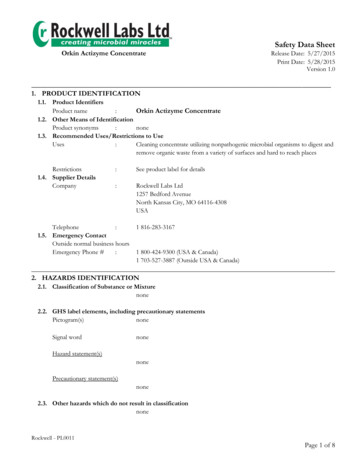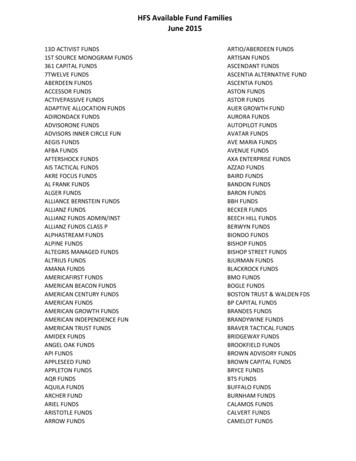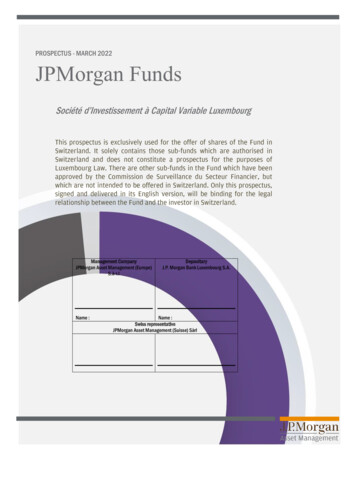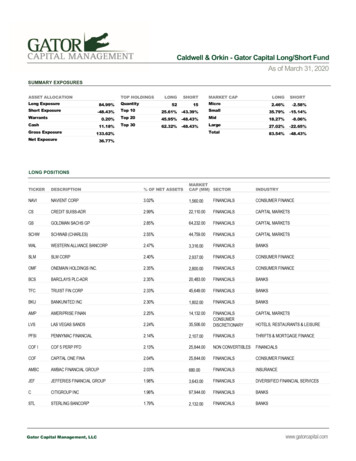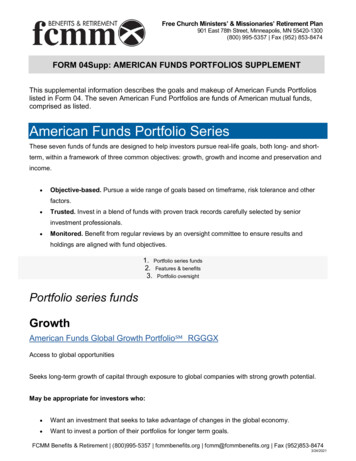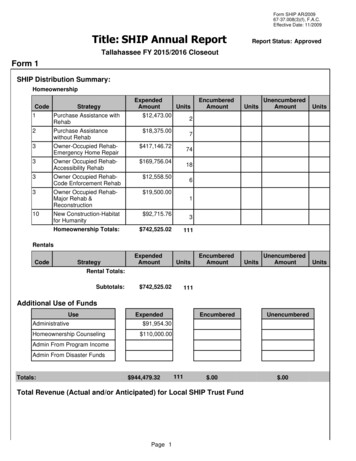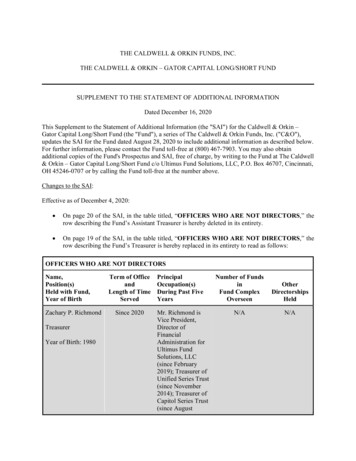
Transcription
THE CALDWELL & ORKIN FUNDS, INC.THE CALDWELL & ORKIN – GATOR CAPITAL LONG/SHORT FUNDSUPPLEMENT TO THE STATEMENT OF ADDITIONAL INFORMATIONDated December 16, 2020This Supplement to the Statement of Additional Information (the "SAI") for the Caldwell & Orkin –Gator Capital Long/Short Fund (the "Fund"), a series of The Caldwell & Orkin Funds, Inc. ("C&O"),updates the SAI for the Fund dated August 28, 2020 to include additional information as described below.For further information, please contact the Fund toll-free at (800) 467-7903. You may also obtainadditional copies of the Fund's Prospectus and SAI, free of charge, by writing to the Fund at The Caldwell& Orkin – Gator Capital Long/Short Fund c/o Ultimus Fund Solutions, LLC, P.O. Box 46707, Cincinnati,OH 45246-0707 or by calling the Fund toll-free at the number above.Changes to the SAI:Effective as of December 4, 2020: On page 20 of the SAI, in the table titled, “OFFICERS WHO ARE NOT DIRECTORS,” therow describing the Fund’s Assistant Treasurer is hereby deleted in its entirety. On page 19 of the SAI, in the table titled, “OFFICERS WHO ARE NOT DIRECTORS,” therow describing the Fund’s Treasurer is hereby replaced in its entirety to read as follows:OFFICERS WHO ARE NOT DIRECTORSName,Position(s)Held with Fund,Year of BirthZachary P. RichmondTreasurerYear of Birth: 1980Term of OfficeandLength of TimeServedSince 2020PrincipalOccupation(s)During Past FiveYearsMr. Richmond isVice President,Director ofFinancialAdministration forUltimus FundSolutions, LLC(since February2019); Treasurer ofUnified Series Trust(since November2014); Treasurer ofCapitol Series Trust(since AugustNumber of FundsinFund ComplexOverseenOtherDirectorshipsHeldN/AN/A
2014); Treasurer ofCommonwealthInternational SeriesTrust (sinceSeptember 2015);Treasurer of OakAssociates Funds(since April 2019);Treasurer ofCentaur MutualFunds Trust (sinceApril 2019).Previously, Mr.Richmond wasAssistant VicePresident, AssociateDirector ofFinancialAdministration forUltimus FundSolutions, LLC(December 2015 toFebruary 2019);Manager, FundAdministration,Huntington AssetServices, Inc.(January 2011 toDecember 2015).Investors should retain this supplement for future reference.
STATEMENT OF ADDITIONAL INFORMATIONAugust 28, 2020THE CALDWELL & ORKIN - GATOR CAPITAL LONG/SHORT FUNDOFTHE CALDWELL & ORKIN FUNDS, INC.Ticker Symbol: COAGX100 South Ashley DriveSuite 895Tampa, Florida 33602Telephone No. (813) 282-7870(800) 467-7903The Caldwell & Orkin - Gator Capital Long/Short Fund (the “Fund”) is a portfolio of The Caldwell & Orkin Funds, Inc. (“Caldwell& Orkin”), an open-end diversified management investment company. The Fund’s objective is to provide long-term capital growth with ashort-term focus on capital preservation.This Statement of Additional Information (“SAI”) of Caldwell & Orkin is not a prospectus and should be read in conjunction with theFund’s Prospectus, dated August 28, 2020 (the “Prospectus”), which has been filed with the U.S. Securities and Exchange Commission(“SEC”) and can be obtained, without charge, by contacting Caldwell & Orkin at the above telephone number or address. This SAI has beenincorporated by reference in its entirety into the Prospectus.This SAI incorporates by reference information from the Fund’s annual report (the “Annual Report”) to shareholders for the fiscalyear ended April 30, 2020. The Annual Report also accompanies this SAI. Additional copies are available, without charge, by contactingthe Fund at (800) 467-7903.GATOR CAPITAL MANAGEMENT, LLC - MANAGER
TABLE OF CONTENTSTHE FUND1INVESTMENT OBJECTIVES, POLICIES AND RISK CONSIDERATIONS1INVESTMENT RESTRICTIONS14DISCLOSURE OF PORTFOLIO HOLDINGS16CODE OF ETHICS17PROXY VOTING POLICIES17MANAGEMENT OF THE FUND18MANAGEMENT AND ADVISORY ARRANGEMENTS23ADDITIONAL INFORMATION ABOUT THE INVESTMENT TEAM25PORTFOLIO TRANSACTIONS AND BROKERAGE ALLOCATION26DETERMINATION OF NET ASSET VALUE27THE DISTRIBUTOR28THE ADMINISTRATOR28PURCHASE OF SHARES29REDEMPTION OF SHARES30SHAREHOLDER SERVICES31DIVIDENDS, DISTRIBUTIONS AND TAXES32PRINCIPAL SHAREHOLDERS37INDEPENDENT REGISTERED PUBLIC ACCOUNTING FIRM38CUSTODIAN38LEGAL COUNSEL38GENERAL INFORMATION38FINANCIAL STATEMENTS AND REPORT OF INDEPENDENT REGISTERED PUBLIC ACCOUNTING FIRM39APPENDIX A – RATINGS OF CORPORATE DEBT OBLIGATIONSA-1APPENDIX B – PROXY VOTING POLICIES AND PROCEDURESB-1
THE FUNDThe Fund is the only series of Caldwell & Orkin, an open-end, diversified management investment company incorporated under the laws ofthe State of Maryland on August 15, 1989. Caldwell & Orkin’s address is: 100 South Ashley Drive, Suite 895, Tampa, Florida 33602, and itstelephone number is (813) 282-7870 or (800) 467-7903. Prior to January 30, 2019, the Fund was named the Caldwell & Orkin MarketOpportunity Fund.INVESTMENT OBJECTIVES, POLICIES AND RISK CONSIDERATIONSReference is made to the sections entitled “Summary Section – Investment Objective”, “Summary Section – Principal Investment Strategies ofthe Fund”, “Summary Section – Principal Risks of Investing in the Fund” and “Additional Information about the Principal Risks of Investing inthe Fund” in the Prospectus for a discussion of the Fund’s investment objectives and policies and principal risks of investing in the Fund. Setforth below is certain further information relating to the Fund generally.General Investment Risks. All investments in securities and other financial instruments involve a risk of financial loss. No assurance can begiven that the Fund’s investment programs will be successful. Investors should carefully review the descriptions of the Fund’s investmentsand their risks described in the Prospectus and this SAI.Borrowing Money. The Fund may borrow up to one-third of its total assets, including the amount of such borrowing, to maintain necessaryliquidity to make payments for redemptions of Fund shares, for temporary emergency purposes or for other purposes. Borrowing involves thecreation of a liability that requires the Fund to pay interest. The risks of borrowing include a higher volatility of the net asset value (“NAV”)of the Fund’s shares and the relatively greater effect on the NAV of the shares caused by declines in the prices of the Fund’s investments,adverse market movements and increases in the cost of borrowing. The effect of borrowing in a declining market could be a greater decreasein NAV per share than if the Fund had not borrowed money. In an extreme case, if the Fund’s current investment income were not sufficient tomeet the interest expense of borrowing, it could be necessary for the Fund to liquidate certain of its investments at an inappropriate time.Changing Fixed Income Market Conditions. Following the financial crisis that began in 2007, the U.S. government and the Board ofGovernors of the Federal Reserve System (the “Federal Reserve”), as well as certain foreign governments and central banks, took steps tosupport financial markets, including seeking to maintain interest rates at or near historically low levels and by purchasing large quantities offixed income securities on the open market, such as securities issued or guaranteed by U.S. government, its agencies or instrumentalities,(“Quantitative Easing”). Similar steps appear to be taking place again in 2020 in an effort to support the economy during the COVID-19pandemic. It is unclear how long these policies will last. In addition, this and other government interventions may not work as intended,particularly if the efforts are perceived by investors as being unlikely to achieve the desired results. When the Federal Reserve determines to“taper” or reduce Quantitative Easing and/or raise the federal funds rate, there is a risk that interest rates across the U.S. financial system willrise. Such policy changes may expose fixed-income and related markets to heightened volatility and may reduce liquidity for certain fixedincome investments, including fixed income investments held by the Fund, which could cause the value of the Fund’s investments and shareprice to decline. To the extent that the Fund invests in derivatives tied to fixed income markets, the Fund will be more substantially exposedto these risks than a fund that does not invest in such derivatives.Commodities Exchange Act Compliance. To the extent the Fund makes investments regulated by the CFTC, it will do so in accordancewith Rule 4.5 under the Commodity Exchange Act (“CEA”). The Fund is operated by an entity that has filed a notice of eligibility forexclusion from the definition of the term “commodity pool operator” in accordance with Rule 4.5. Therefore, the Fund will not be subject toregistration or regulation as a commodity pool operator under the CEA.Convertible Securities. The Fund may buy securities convertible into common stock or other equity in a company, such as convertiblebonds, convertible preferred stocks and warrants. A warrant is an instrument issued by a corporation that gives the holder the right tosubscribe to a specific amount of the corporation’s capital stock at a set price for a specified period of time. Warrants do not representownership of the underlying securities, but only the right to buy the securities. The prices of warrants do not necessarily move parallel to theprices of underlying securities. Warrants may be considered speculative in that they have no voting rights, pay no dividends, and have norights with respect to the assets of a corporation issuing them. Convertible bonds are subject to risks associated with fixed incomeinvestments, such as credit risk, interest rate risk, and maturity risk. Convertible preferred stocks are subject to the risks of preferred stocks,such as equity risk and risks that the issuer will not be able to pay any preferred dividend or other preference. Warrants are subject to risksassociated with options, including the possible lack of a liquid market for resale of the warrants, potential price fluctuations as a result ofspeculation or other factors, and failure of the price of the underlying security to reach or have reasonable prospects of reaching a level atwhich the warrant can be prudently exercised (in which event the warrant may expire without being exercised, resulting in a loss of a Fund’sentire investment therein).1
Derivative Instruments. The Fund may use a variety of derivative instruments (including both long and short positions) in an attempt toenhance the Fund’s investment returns, to hedge against market and other risks in the portfolio, to add leverage to the portfolio and/or toobtain market exposure with reduced transaction costs.Generally, derivatives are financial contracts whose value depends on, or is derived from, the value of an underlying asset, reference rate orindex and may relate to, among other things, stocks, bonds, interest rates, currencies or currency exchange rates, commodities, related indicesand other assets. Examples of derivatives and information about some types of derivatives and risks associated therewith follows. Thederivatives market is continually evolving and the Fund may invest in derivatives other than those described below.The value of some derivative instruments in which the Fund may invest may be particularly sensitive to changes in prevailing interest rates,and, like the other investments of the Fund, the ability of the Fund to utilize these instruments successfully may depend in part upon theirability to forecast interest rates and other economic factors correctly. If the Manager incorrectly forecasts such factors and has taken positionsin derivative instruments contrary to prevailing market trends, the Fund could suffer losses. If the Manager incorrectly forecasts interest rates,market values or other economic factors in utilizing a derivatives strategy, the Fund might have been in a better position if it had not enteredinto the transaction at all. Also, suitable derivative transactions may not be available in all circumstances. The use of derivative strategiesinvolves certain special risks, including a possible imperfect correlation, or even no correlation, between price movements of derivativeinstruments and price movements of related investments. While some strategies involving derivative instruments can reduce the risk of loss,they also can reduce the opportunity for gain or even result in losses by offsetting favorable price movements in related investments orotherwise, due to the possible inability of the Fund to purchase or sell a portfolio security at a time that otherwise would be favorable or thepossible need to sell a portfolio security at a disadvantageous time because the Fund is required to maintain asset coverage or offsettingpositions in connection with transactions in derivative instruments, and the possible inability of the Fund to close out or to liquidate itsderivatives positions. The Fund’s use of derivatives may increase or accelerate the amount of ordinary income recognized by shareholders.Options on Securities and Indices. The Fund may, among other things, purchase and sell put and call options on equity, debt or othersecurities or indices in standardized contracts traded on foreign or domestic securities exchanges, boards of trade, or similar entities, orquoted on the National Association of Securities Dealers Automated Quotations (“NASDAQ”) System or on a regulated foreign over-thecounter market, and agreements, sometimes called cash puts, which may accompany the purchase of a new issue from a dealer. Among otherreasons, the Fund may purchase put options to protect holdings in an underlying or related security against a decline in market value, and maypurchase call options to protect against increases in the prices of securities it intends to purchase, pending its ability to invest in suchsecurities in an orderly manner.An option on a security (or index designed to reflect features of a particular financial or securities market, a specific group of financialinstruments or securities, or certain economic indicators) is a contract that gives the holder of the option, in return for a premium, the right tobuy from (in the case of a call) or sell to (in the case of a put) the writer of the option the security underlying the option (or the cash value ofthe index) at a specified exercise price at any time during the term of the option. The writer of an option on a security has the obligation uponexercise of the option to deliver the underlying security upon payment of the exercise price or to pay the exercise price upon delivery of theunderlying security. Upon exercise, the writer of an option on an index is obligated to pay the difference between the cash value of the indexand the exercise price multiplied by the specified multiplier for the index option.2
If the Fund writes a call (put) option on an underlying security it owns (is short), the option is sometimes referred to as a “covered option.”When writing a covered option, the Fund is more protected than if the Fund writes an option on a security it does not hold. If the Fund writesa call (put) option on an underlying security it does not own, the option is sometimes referred to as a “naked option.” The Fund may write“naked” call options on individual securities or instruments in which it may invest but that are not currently held by the Fund. When writing“naked” call options, the Fund must deposit and maintain sufficient margin with the broker-dealer through which it wrote the “naked” calloption as collateral to ensure that it meets its obligations as the writer of the option. The Fund is further subject to the segregationrequirements described below when it writes “naked” call options. Such segregation will ensure that the Fund has assets available to satisfyits obligations with respect to the transaction, but will not limit the Fund’s exposure to loss. During periods of declining securities prices orwhen prices are stable, writing “naked” call options can be a profitable strategy to increase the Fund’s income with minimal capital risk.However, when the price of the security underlying the written option increases, the Fund is exposed to an increased risk of loss, because ifthe price of the security underlying the option exceeds the option’s exercise price, the Fund will lose the difference minus any premiumreceived from writing the option. “Naked” written call options are riskier than covered call options because there is no underlying securityheld by the Fund that can act as a partial hedge. “Naked” written call options have speculative characteristics, and the potential for loss istheoretically unlimited as there is no limit to how much the value of the underlying asset may increase. When a “naked” written call option isexercised, the Fund must purchase the underlying security to meet its delivery obligation or make a payment equal to the value of itsobligation in order to close out the option. There is also a risk, especially with less liquid preferred and debt securities or small capitalizationsecurities, that the securities may not be available for purchase.A naked put option is a position in which a buyer writes a put option and has no short position in the underlying stock. A naked put optionmay be used when the Fund expects the underlying stock to be trading above the strike price at the time of expiration. The Fund will benefitfrom a naked put option if the underlying stock is trading above the strike price at the time of the expiration of the put option and expiresworthless because the Fund will keep the entire premium. The Fund could lose money if the price of the underlying stock is below the strikeprice because the put may be exercised against the Fund, causing the Fund to buy the stock at the strike price.If an option written by the Fund expires unexercised, the Fund realizes a capital gain equal to the premium received at the time the option waswritten. If an option purchased by the Fund expires unexercised, the Fund realizes a capital loss equal to the premium paid. Prior to the earlierof exercise or expiration, an option may be closed out by an offsetting purchase or sale of an option of the same series (type, exchange,underlying security or index, exercise price, and expiration). In addition, the Fund may sell put or call options it has previously purchased,which could result in a net gain or loss depending on whether the amount realized on the sale is more or less than the premium and othertransaction costs paid on the put or call option that is sold. There can be no assurance, however, that a closing purchase or sale transactioncan be effected when the Fund desires.The Fund will realize a capital gain from a closing purchase transaction if the cost of the closing option is less than the premium receivedfrom writing the option, or, if it is more, the Fund will realize a capital loss. If the premium received from a closing sale transaction is morethan the premium paid to purchase the option, the Fund will realize a capital gain or, if it is less, the Fund will realize a capital loss. Theprincipal factors affecting the market value of a put or a call option include supply and demand, interest rates, the current market price of theunderlying security or index in relation to the exercise price of the option, the volatility of the underlying security or index, and the timeremaining until the expiration date.While, as mentioned above, the Fund may write naked call or put options, such options will nonetheless be deemed to be “covered” as suchterm is used in the context of Section 18 of the Investment Company Act of 1940, as amended (“1940 Act”). In the case of a call option on asecurity, a call option is covered for these purposes if the Fund segregates assets determined to be liquid by the Manager in accordance withprocedures approved by the Caldwell & Orkin Board of Directors (the “Board”) in an amount equal to the contract value of the position(minus any collateral deposited with a broker-dealer), on a mark-to-market basis. The option is also covered if the Fund owns the securityunderlying the call or has an absolute and immediate right to acquire that security without additional cash consideration (or, if additional cashconsideration is required, cash or other assets determined to be liquid by the Manager in accordance with procedures approved by the Boardin such amount are segregated) upon conversion or exchange of other securities held by the Fund. For a call option on an index, the option iscovered if the Fund segregates assets determined to be liquid by the Manager. A call option is also covered if the Fund holds a call on thesame index or security as the call written where the exercise price of the call held is (i) equal to or less than the exercise price of the callwritten, or (ii) greater than the exercise price of the call written, provided the difference is segregated by the Fund in assets determined to beliquid by the Manager. A put option on a security or an index is “covered” if the Fund segregates assets determined to be liquid by theManager in accordance with procedures approved by the Board equal to the exercise price. A put option is also covered if the Fund holds aput on the same security or index as the put written where the exercise price of the put held is (i) equal to or greater than the exercise price ofthe put written, or (ii) less than the exercise price of the put written, provided the difference is segregated by the Fund in assets determined tobe liquid by the Manager.3
OTC Options. The Fund may also purchase and write over-the-counter (“OTC”) options. OTC options differ from traded options in that theyare two-party contracts, with price and other terms negotiated between buyer and seller, and generally do not have as much market liquidity asexchange-traded options. The Fund may be required to treat as illiquid OTC options purchased and securities being used to cover certainwritten OTC options, and they will treat the amount by which such formula price exceeds the intrinsic value of the option (i.e., the amount, ifany, by which the market price of the underlying security exceeds the exercise price of the option) as an illiquid investment. The Fund mayalso purchase and write dealer options.Risks Associated with Options on Securities and Indices. There are a number of risks associated with transactions in options on securitiesand indices. For example, there are significant differences between the securities and options markets that could result in an imperfectcorrelation between these markets, causing a given transaction not to achieve the intended result. A decision as to whether, when and how touse options involves the exercise of skill and judgment, and even a well-conceived transaction may be unsuccessful because of marketbehavior or unexpected events.There can be no assurance that a liquid market will exist when the Fund seeks to close out an option position. If the Fund were unable toclose out an option that it had purchased on a security or index, it would have to exercise the option in order to realize any profit or the optionmay expire worthless. If the Fund were unable to close out a call option that it had written on a security held in its portfolio, it would not beable to sell the underlying security unless the option expired without exercise. As the writer of a call option on an individual security held inthe Fund’s portfolio, the Fund foregoes, during the option’s life, the opportunity to profit from increases in the market value of the security orindex position covering the call option above the sum of the premium and the exercise price of the call but has retained the risk of loss (net ofpremiums received) should the price of the underlying security or index position decline. Similarly, as the writer of a call option on asecurities index or ETF, the Fund forgoes the opportunity to profit from increases in the index or ETF over the strike price of the option,though it retains the risk of loss (net of premiums received) should the price of the Fund’s portfolio securities decline.The value of call options written by the Fund will be affected by, among other factors, changes in the value of underlying securities (includingthose comprising an index), changes in the dividend rates of underlying securities (including those comprising an index), changes in interestrates, changes in the actual or perceived volatility of the stock market and underlying securities and the remaining time to an option’sexpiration. The value of an option also may be adversely affected if the market for the option is reduced or becomes less liquid. The writerof an option generally has no control over the time when it may be required to fulfill its obligation as a writer of the option. Once an optionwriter has received an exercise notice, it cannot effect a closing purchase transaction in order to terminate its obligation under the option andmust deliver the underlying security at the exercise price.The hours of trading for options may not conform to the hours during which the securities held by the Fund are traded. To the extent that theoptions markets close before the markets for the underlying securities, significant price and rate movements can take place in the underlyingmarkets that may not be reflected in the options markets. In addition, the Fund’s options transactions will be subject to limitations establishedby each of the exchanges, boards of trade or other trading facilities on which the options are traded. An exchange, board of trade or othertrading facility may order the liquidation of positions found to be in excess of these limits, and it may impose other sanctions that couldadversely affect the Fund’s engaging in options transactions.4
If a put or call option purchased by the Fund is not sold when it has remaining value, and if the market price of the underlying security orindex remains equal to or greater than the exercise price (in the case of a put), or remains less than or equal to the exercise price (in the caseof a call), the Fund will lose its entire investment in the option. Also, where a put or call option on a particular security or index is purchasedto hedge against price movements in a related security or index, the price of the put or call option may move more or less than the price of therelated security or index. Furthermore, if trading restrictions or suspensions are imposed on the options markets, the Fund may be unable toclose out a position. Similarly, if restrictions on exercise were imposed, the Fund might be unable to exercise an option it has purchased.Except to the extent that a call option on an index or ETF written by the Fund is covered by an option on the same index or ETF purchased bythe Fund, movements in the index or ETF may result in a loss to the Fund; however, such losses may be mitigated by changes in the value ofthe Fund’s securities during the period the option was outstanding (based, in part, on the extent of correlation (if any) between theperformance of the index or ETF and the performance of the Fund’s portfolio securities).Foreign Currency Options. The Fund may buy or sell put and call options on foreign currencies in various circumstances, including, but notlimited to, as a hedge against changes in the value of the U.S. dollar (or another currency) in relation to a foreign currency in which the Fund’ssecurities may be denominated or to cross-hedge or in an attempt to increase the total return when the Manager anticipates that the currencywill appreciate or depreciate in value. In addition, the Fund may buy or sell put and call options on foreign currencies either on exchanges orin the over-the-counter market. A put option on a foreign currency gives the purchaser of the option the right to sell a foreign currency at theexercise price until the option expires. A call option on a foreign currency gives the purchaser of the option the right to purchase the currencyat the exercise price until the option expires. Currency options traded on U.S. or other exchanges may be subject to position limits, which maylimit the ability of the Fund to reduce foreign currency risk using such options.Option Combinations. The Fund may combine options transactions, which combinations may be in the form of option spreads or optioncollars. Put spreads and collars are designed to protect against a decline in value of a security the Fund owns. A collar involves the purchaseof a put and the simultaneous writing of a call on the same security at a higher strike price. The put protects the investor from a decline in theprice of the security below the put’s strike price. The call means that the investor will not benefit from increases in the price of the securitybeyond the call’s strike price. In a put spread, an investor purchases a put and simultaneously writes a put on the same security at a lowerstrike price. This combination protects the investor against a decline in the price down to the lower strike price. The premium received forwriting the call (in the case of a collar) or writing the put (in the case of a put spread) offsets, in whole or in part, the premium paid topurchase the put.In a call spread, an investor purchases a call and simultaneously sells a call on the same security, with the call sold having a higher strikeprice than the call purchased. The purchased call is designed to provide exposure to a potential increase in the value of a security an investorowns. The premium received for writing the call offsets, in part, the premium paid to purchase the corresponding call, but it also means thatthe investor will not benefit from increases in the price of the security beyond the sold call’s strike price.The Fund may write straddles (covered or uncovered) consisting of a combination of a call and a put written on the same underlying securityor index, with the same strike price and expiration date. A straddle will be covered when sufficient assets
THE CALDWELL & ORKIN FUNDS, INC. Ticker Symbol: COAGX 100 South Ashley Drive Suite 895 Tampa, Florida 33602 Telephone No. (813) 282-7870 (800) 467-7903 The Caldwell & Orkin - Gator Capital Long/Short Fund (the "Fund") is a portfolio of The Caldwell & Orkin Funds, Inc. ("Caldwell & Orkin"), an open-end diversified management investment .



